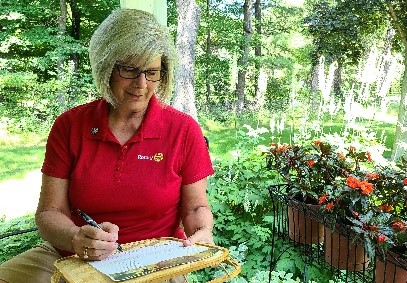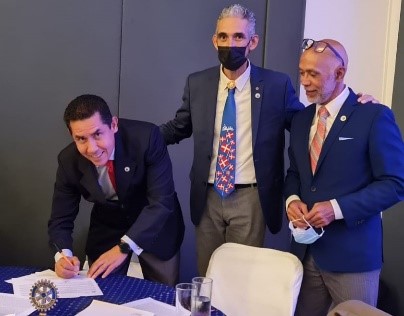
Youth Service - Interact
Thanks to Karen Kendrick-Hands, our super-collaborator on all things environmental, co-founder and director of the Environmental Sustainability Rotary Action Group (ESRAG), and proud 6250 Rotarian, we TriCon 2022 District Governors made the acquaintance of Rotarian Joe Richardson. Joe lives in Maryland and founded Lunch out of Landfills, one of ESRAG’s projects.
Lunch out of Landfills aims to:
- Compost food scraps: Reduce greenhouse gases from landfills and help build healthy soils
- Clean up and decontaminate recycling collection
- Recover good food and feed hungry people
- Reduce use of single use plastics and promote low-trash lunches from home
 |  |
| Step One: Assess what’s in the garbage | Success! One into landfills, now to neighbors who are food insecure |
Engaging Interactors, Environmental Clubs, and budding scientists and educators, Lunch out of Landfills has had stunning success in early stages. And the work brings lasting change – from elementary school students to their homes and to the future – this program works and matters.
Please take time to watch Joe’s presentation to Districts 6220, 6250 and 6270, the student leadership stories told following the presentation, and the students’ promotional piece. Will you be the one to engage young leaders in your community to take action for lasting change?
The importance and plan of Lunch out of Landfills https://youtu.be/EmG7xXqruwU
Rotary’s role and student stories https://youtu.be/pyL-7uVQ_7c
DG Karen Hebert
Community Service Committee
Operation Pollination
At its August meeting, your District 6250 Board of Directors voted to join Operation Pollination. District 6250 has resolved to strengthen and support our Interact, Rotaract, and Rotary Clubs in their efforts to:
 Increase and improve Pollinator Habitat: Identify existing pockets of pollinator habitat, and then develop a network of habitat on public and private lands to create a nectar corridor for migratory and non-migratory pollinator species
Increase and improve Pollinator Habitat: Identify existing pockets of pollinator habitat, and then develop a network of habitat on public and private lands to create a nectar corridor for migratory and non-migratory pollinator speciesPublic-Private Partnerships: Develop strategic planning and partnerships to improve or create habitat for pollinators as well as provide educational opportunities within the scope of the resolution. Collaborate with partners already invested in pollinator habitat protection and restoration.
Education: Encourage voluntary, collaborative and locally led conservation that has proven to be effective in maintaining and enhancing working landscapes. This may include, but is not limited to, planting pollinator gardens, creating meadows and diversified lawns, building bee blocks, and avoiding or limiting pesticide use and mowing.
Research: Develop and/or promote citizen science opportunities for improving pollinator habitat on residential properties and at public centers.
Friends in Mexico joined just after 6250
Watch these webinar videos to be inspired ( Part I) and equipped (Part 2)!
Part I) and equipped (Part 2)!
 Part I) and equipped (Part 2)!
Part I) and equipped (Part 2)!Operation Pollination Part 1 https://youtu.be/dkEO2ydQAM4
Operation Pollination Part 2 https://youtu.be/H5Aq_bEu1HA
Survivor Clothing Project – Jessica Randall
 |  |
When a victim of sexual assault is seen in the Emergency Room after an assault, their clothing is often taken into evidence. What most people don’t know is that survivors of sexual assault are often sent home in paper scrubs and disposable underwear. This troubling fact is something I learned while reading an article one afternoon before COVID-19 hit. The fact that this was happening made me angry; it was an injustice to these vulnerable patients. I had to know if this was happening in my community and was shocked to find out that it was. I felt a moral obligation to step up and do something. So that is what I did.
My name is Jessica Randall. I am going to be a senior at Onalaska High School in Onalaska, WI and I am the incoming Director of Service Projects at our high school’s Interact Club.
In February of 2021, I created the Survivor Clothing Drive to address the indignities I had uncovered. My plan was to collect clothes and undergarments to donate to local hospitals. Little did I know that my clothing drive would transform into a year-round non-profit that changed the way Emergency Rooms sent survivors home.
It all started with an email. I emailed the Emergency Room staff asking if there was interest in receiving donations. They were delighted and shocked that they didn’t think of it first. And so it began.. The response was tremendous: clothing and donations started pouring in, and I ended up having to extend the timeline of the drive because people kept giving. The support was overwhelming: it led to news stories with the local news outlets, presentations at our local Rotary clubs, churches, etc. It took me hours to sort donations, manage money, and contact hospitals. And in only a few months, I raised $3,000 and collected 1,200 items, filling an entire room in my house with boxes of clothes and undergarments.
In late April and early May, the donations were delivered to local hospitals including Gundersen Health System and Mayo Health Clinic. Fourteen boxes were loaded onto stretchers and presented to the nurses, doctors, and support staff that came to receive the clothing and express their thanks. It was emotional to hold the itchy paper scrubs that these donations were replacing. After seeing the initial impact, I realized this need wasn’t going away, so I decided to commit to ongoing support, chose the name “Survivor Clothing Project” and planned to continue my project year-round in accordance with hospitals' needs. Though I have made the initial donations, my work is far from over. This isn’t just about the physical clothing: the Survivor Clothing Project is about spreading awareness, destigmatizing sexual assault, and helping my fellow human beings.
It is a rewarding experience to make a difference in people’s lives, both the people receiving the clothes and those inspired to take action. One of the biggest lessons I took from this experience is how easy it is to create change. Many people have ideas and never put them into action because they do not have experience or connections. I didn’t have the experience or any connections either. I started with only an idea that grew to make the Survivor Clothing Project a huge success. I am now supplying multiple large hospitals, creating a year-round fund, and making a long-term, self-renewing investment. I hope the success of the Survivor Clothing Project can be an inspiration to others and increase their confidence so that they will start bringing their ideas to life because there are endless unmet needs in our world. The Survivor Clothing Project has helped to inspire my community, spread awareness of sexual assault, and is providing a much-needed service to the hospitals and survivors, and will hopefully inspire more positive change for years to come.
To find out more about the Survivor Clothing Project and how to get involved, email survivorclothingproject@gmail.com or check out its Instagram and Facebook accounts @survivorclothingproject.
Jessica Randal